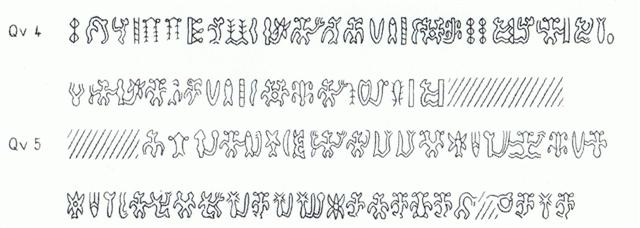| H |
 |
 |
 |
 |
| Hb2-30 |
Hb2-31 |
Hb2-32 |
Hb2-33 |
 |
 |
 |
 |
| Hb2-34 |
Hb2-35 (735) |
Hb2-36 |
Hb2-37 |
 |
 |
 |
 |
| Hb2-38 |
Hb2-39 |
Hb2-40 |
Hb2-41 |
| Q |
 |
 |
 |
 |
| *Qb5-12 |
*Qb5-13 |
*Qb5-14 |
*Qb5-15 |
 |
 |
 |
 |
| *Qb5-16 |
*Qb5-17 (591) |
*Qb5-18 |
*Qb5-19 |
 |
 |
 |
 |
| *Qb5-20 |
*Qb5-21 |
*Qb5-22 |
*Qb5-23 |
| P |
 |
 |
 |
 |
| Pb4-41 |
Pb4-42 |
Pb4-43 |
Pb4-44 |
 |
 |
 |
 |
| Pb4-45 |
Pb4-46 (745) |
Pb4-47 |
Pb4-48 |
 |
 |
 |
 |
| Pb4-49 |
Pb4-50 |
Pb4-51 |
Pb4-52 |
Niu (palm tree, coconut, spinning top) then arrive:
 |
 |
| Hb2-42 (742) |
Hb2-43 |
 |
 |
| *Qb5-24 |
*Qb5-25 (599) |
 |
 |
 |
 |
| Pb4-53 |
Pb4-54 |
Pb4-55 |
Pb4-56 (755) |
 |
 |
 |
 |
 |
| Hb2-44 |
Hb2-45 |
Hb2-46 (746) |
Hb2-47 |
Hb2-48 |
 |
 |
 |
 |
 |
| *Qb5-26 |
*Qb5-27 |
*Qb5-28 |
*Qb5-29 |
*Qb5-30 (604) |
 |
 |
 |
 |
 |
| Pb5-1 |
Pb5-2 |
Pb5-3 |
Pb5-4 (759) |
Pb5-5 |
Glyph line Hb3 is beginning where in Q there could be an allusion to 18 * 29½ = 531. Furthermore, there is a strong Sign in the broken rona (sculpture, figure, not the real thing, sign) glyph:
 |
 |
- |
 |
 |
 |
| Hb3-1 |
Hb3-2 |
Hb3-3 |
Hb3-4 (752) |
Hb3-5 |
 |
 |
- |
 |
 |
 |
| *Qb5-31 |
*Qb5-32 |
*Qb5-33 |
*Qb5-34 (608) |
*Qb5-35 |
 |
 |
 |
 |
 |
 |
| Pb5-6 |
Pb5-7 |
Pb5-8 |
Pb5-9 |
Pb5-10 (765) |
Pb5-11 |
 |
 |
 |
 |
| Hb3-6 |
Hb3-7 |
Hb3-8 (756) |
Hb3-9 |
 |
 |
 |
 |
| *Qb5-36 |
*Qb5-37 |
*Qb5-38 (612) |
*Qb5-39 |
 |
 |
 |
 |
| Pb5-12 |
Pb5-13 |
Pb5-14 (769) |
Pb5-15 |
 |
 |
 |
 |
| Hb3-10 |
Hb3-11 |
Hb3-12 |
Hb3-13 (761) |
| ... |
... |
... |
| *Qb5-40 |
*Qb5-41 |
*Qb5-42 (616) |
 |
 |
 |
| Pb5-16 |
Pb5-17 |
Pb5-18 (773) |
It is uncertain whether there are meant to be 3 or 4 empty glyph spaces at the end of line Qb5. If the number should be read as 3 (the same as the number of visible parallel glyphs in P), then the creator of the text could have intended room for 229 glyphs on side b up to and including the last glyph in line b5.
387 (my estimated room for glyphs on side a) + 229 (my suggested number for the the text on side b up to line b6) = 616 (= 14 * 44) and 54 * 2 = 108. The distance in days to Pb5-18 could be 773 - 616 = 157 (= 314 / 2) and the distance to Hb3-13 could be 761 - 616 = 145 ( = 5 * 29). Glyph line Qb5 is the 14th counted from Qa1 and 616 / 14 = 44.
If the last glyph in line Qb5 should correspond to number 229, then glyph number 222 will be a week earlier, at the first part of the broken rona.
However, it is noteworthy that the glyphs adjoining the empty glyph spaces are fully visible and intact. This suggests there sometimes never were any glyphs in the empty places, e.g. between mea ke and manu rere hua in line b3:
 |
 |
... |
 |
| Qb3-31 |
Qb3-32 |
*Qb3-33 |
*Qb3-34 (518) |
Therefore the number to count with from the beginning of side b ought to be 229:
| b1 |
51 |
51 |
- |
51 |
| b2 |
46 |
97 |
- |
97 |
| b3 |
50 |
147 |
*1 |
148 |
| b4 |
39 |
186 |
- |
187 |
| b5 |
39 |
225 |
*3 |
229 |
From Barthel's picture of side b it is clear that there is a further room free from glyphs at the end of line b4 and at the beginning of line b5, possibly to be measured as 5 + 3 = 8:

I have not counted with this free from glyphs part on the Q tablet, for instance because it could be of another kind than those 1 + 3 = 4 empty glyph spaces discussed above. Vast spaces are hard to count.
































































































































